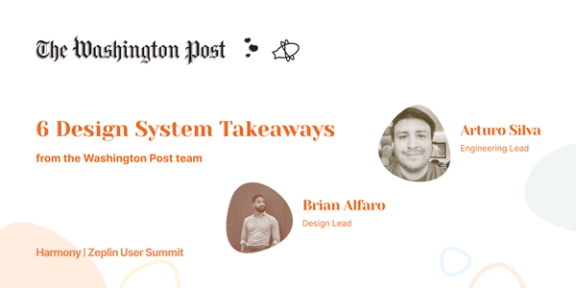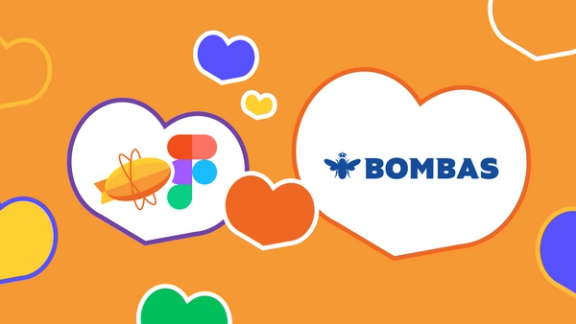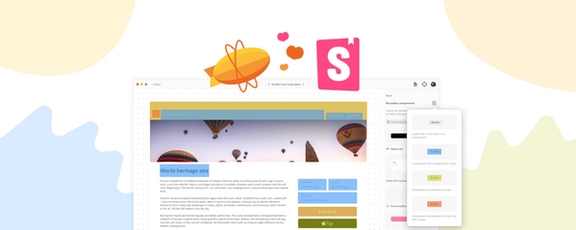Meet Becky Specking, a UI/UX designer and Founder of speck studio who has consulted for Fortune 500 companies, worked directly with companies like JLL, Motorola Solutions, Ulta Beauty, bp, AT&T, Edelman, Carrier HVAC and multiple startups.
She specializes in user-centered design and her commitment to design accessibility, inclusivity, and sustainability shapes her approach towards the design process and product design strategy. She also happens to also be a long-time Zeplin user 🧡, helping all of the product teams she works with document and deliver designs that follow ethical design practices.
Given her passion and experience in building user-first product experiences — a topic that resonates with us a lot here at Zeplin! — we jumped at the chance to learn about Becky’s background and design process, as well her hard-earned insights around some crucial topics for design and development teams, including:
- Accessible design and development
- The design-to-dev workflow
- Using Zeplin in her process and with her clients
- Advice on building accessible product experiences
Read on for the full interview!
About Becky
1. Tell us about yourself! Who are you, what do you do, and how does accessibility relate to your work?
I'm a design leader based in Chicago, IL. My design expertise is across UX Design, UI Design as well as Product Design. I’m currently working as a design consultant through my agency, Speck Studio.
I’ve always been passionate about creating digital experiences that are not only beautiful but profoundly inclusive. This has driven me to understand the different tenants of accessibility and how design can embrace practices to prioritize accessibility throughout the entire lifecycle. As a design leader who works across different platforms and media, it’s a priority for me to steer projects towards solutions that anticipate and address the needs of all users, those with and without disabilities.
In my approach, accessibility isn't merely a feature; it's a foundational ethos that influences every decision a designer or team makes. By integrating accessibility into my design philosophy, I ensure that accessibility is an integral consideration in each design phase, contributing to an ethical design approach I can use to enhance the impact of my clients’ work.
Accessible design and development
2. How would you define accessibility in design — what are the goals, who is it for, and what are some guiding principles?
Accessibility in design means opening up our digital creations to everyone, regardless of ability, and ensuring they can effectively use our creations. It’s about designing with a deep-seated empathy, ensuring that each interaction is as intuitive for someone with disabilities as it is for anyone else. As we design the journeys that shape experiences, it’s important to make sure each journey variation provides an amazing and meaningful experience, not a lesser one because it’s compromising to accommodate something.
When we design, we’re telling a story. So, what story are we trying to tell? And, how can we make sure everyone gets to experience the same story?
Our goal as designers is to demolish barriers that might prevent anyone from fully engaging with our products. We operate under guiding principles such as inclusivity, clarity, and adaptability—ensuring our designs are easily perceivable, operable, and understandable by all. It’s not just about adhering to standards but about pushing the envelope to innovate ways that our products can cater to overlooked needs.
3. Can you walk through specific steps you take for accessibility in your design process, from beginning to shipped product?
Ideally, you’d embed accessibility into your design process, and naturally incorporate inclusive practices into each phase as you craft. These are examples of how embedding accessibility into a typical design process may look:
- Empathize: Deep Diving into User Context
Deeply understand the user through conducting immersive research, and engage directly with users from various backgrounds, including those with disabilities. This phase is essential as it grounds the project in real user experiences, ensuring that designs are informed by true user needs and not just theoretical assumptions.
- Define: Establishing Inclusive Objectives
With a rich understanding of users, you’d transition to defining key objectives which includes treating accessibility considerations as primary objectives rather than special requirements. Set specific, measurable goals for accessibility early on in the project as a guide, such as ensuring screen reader compatibility or achieving an AA level in the Web Content Accessibility Guidelines (WCAG).
- Ideate: Creative Problem Solving with Accessibility in Mind
Prioritize your accessibility objectives when you’re brainstorming and concepting. This often involves innovative layouts, intuitive interactions, and visually clear design elements that accommodate users with varying abilities. Remember to include cross-functional teams in your design sessions and, where possible, incorporate feedback from accessibility advocates or directly from users from the research phase.
- Prototype: Building with Accessibility from the Start
Create interactive prototypes not only to look good but also to be functional for users with disabilities. Use these prototypes to test assumptions, refine approaches, and ensure that the user experience is seamless for everyone. This phase is critical for testing and optimizing accessibility features, such as keyboard navigability and compatibility with assistive technologies.
- Test: Rigorous Validation for Usability and Accessibility
Evaluate your prototypes to meet accessibility standards. Do structured testing sessions with diverse user groups, including those who use assistive technologies. The aim is to uncover any barriers that might prevent users from having a fully accessible experience, allowing for informed adjustments before finalizing the design.
- Implement: Ensuring Accessibility in Development
During the implementation phase, detailed design specifications are what guide the development team. Those detailed design specifications should include accessibility annotations, so developers can integrate accessibility into the codebase from the ground up. Maintain close collaboration between designers and developers to resolve any issues that arise during this translation from design to code.
- Learn: Continuous Learning and Adaptation Post-Launch
Post-launch, the learning continues. Actively collect feedback from users, and monitor the performance of the product in various real-world environments. This ongoing evaluation helps you understand if the accessibility efforts are successful or if there are aspects that you need to revisit. Focus on continuous improvement based on real user feedback so you can ensure that the products not only complies with accessibility standards at launch, but also evolves to remain effective as technologies and user needs change.
Integrating accessibility into every phase of the design process organically ensures that it’s not an afterthought, but a fundamental, enduring aspect of the product design philosophy. This approach not only makes the products more inclusive but also enriches the design practice and leads to more innovative solutions.
4. What are some common misconceptions — and mistakes — you've seen when it comes to accessibility in design and development?
One misconception is that accessibility is only relevant to a niche group of users. In reality, 1 in 6 people globally lives with some type of disability; that’s 1.3 billion. Designing with accessibility in mind improves the user experience for everyone, not just a few.
Another common mistake is to treat accessibility as a final 'check' rather than an integral part of the design process, often leading to subpar solutions that fail to truly serve the needs of all users. It’s also critical to address the technical side properly—you must use semantic HTML and appropriate ARIA roles to ensure that assistive technologies can accurately interpret and navigate content.
Accessibility needs can show up in unexpected ways, like how we write and communicate with our users. Sometimes accessibility is thought of as just ‘color contrast’ but it’s much more than that, and there are so many ways to enhance the accessibility of your product.
The design-to-dev workflow
5. How do these steps impact design-to-dev collaboration, and how accessibility ultimately shows up in the final product experience?
Incorporating accessibility from the very beginning dramatically improves the dynamics between our designers and developers. It fosters a culture of collaboration and mutual understanding, ensuring that teams are aligned on the importance of building accessible products, as well as what that looks like for each team.
Designers will have accessibility guidelines built into the patterns and design system, while developers have accessibility standards they follow and build into the technical side. It’s important for both teams to understand each other’s language around accessibility and what accessibility best practices look like. This synergy not only streamlines the process but also enhances the overall quality and inclusivity of the final product, as every team member becomes a steward of accessibility.
When this collaboration happens well, the final product experience will be fully accessible without compromising on form or functionality, because both design and development have aligned their best practices.
6. How does Zeplin help you and your clients achieve your goals with accessible design and development? What specific parts of your workflow does it improve or replace?
Zeplin has been instrumental in bridging the gap between the design team’s intentions and the final implemented product. It simplifies the communication of design specs, especially those relating to accessibility features, ensuring that developers have clear, actionable information.
Zeplin enhances our workflow by providing a shared space where both design and development teams can collaborate effectively, keeping accessibility at the forefront. It’s also incredibly helpful to have design specs and accessibility features documented in a way that’s easy to share and walk through with our business stakeholders.
I’m just now exploring the latest updates from Zeplin’s Styleguides Sync, so I’m sure that will offer even more opportunities to better collaborate with teams.
Tips for building accessible product experiences
7. What’s your advice to designers or teams getting started with Accessibility? Top / favorite resources to recommend?
If you’re starting out with accessibility, embrace it as a core aspect of your design philosophy, and practice prioritizing it in every part of your design process; being curious about accessibility can uncover many more opportunities for improvements and exploration.
Familiarize yourself with resources on the web, like the Web Content Accessibility Guidelines (WCAG) for foundational knowledge, the A11Y Project for practical advice and Microsoft’s Inclusive Design Principles with toolkits and guides.
I also highly recommend taking a look at The Ad Hoc Accessibility Beyond Compliance Playbook. They have a lot of great resources for adopting accessibility and they have a mindset of ‘Accessibility Beyond Compliance’ that offers a great approach for embedding accessibility into your process.
Remember, the journey toward excellent accessibility is ongoing—always be learning, adapting, and putting your users first. Championing accessibility, and inclusivity, is an important part of creating an ethically-designed product. With careful attention to accessibility throughout our entire process, we not only enhance our capacity to design inclusively but also set a standard in the industry for what accessible digital products should look and feel like.
Thank you to Becky for sharing her knowledge about designing for accessibility, and her inspiring perspective about always thinking deeply about the user experience. We’re proud that Zeplin is part of your process. 🧡
If you’re curious about how you can also use Zeplin for your client work or within your product organization for better design documentation, organization, and collaboration — you can try Zeplin for free.




